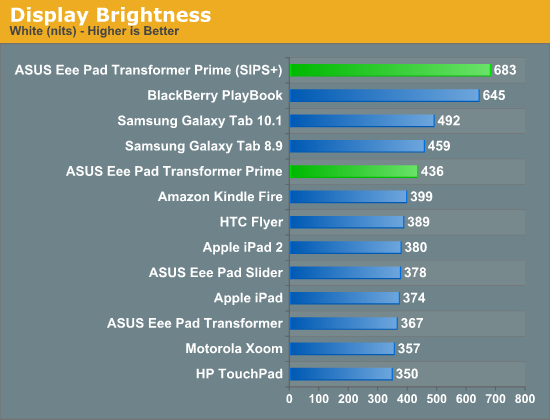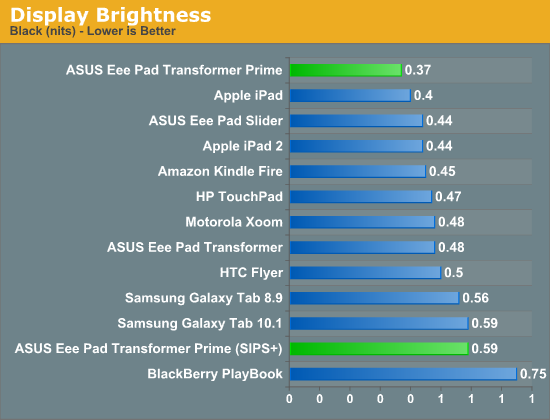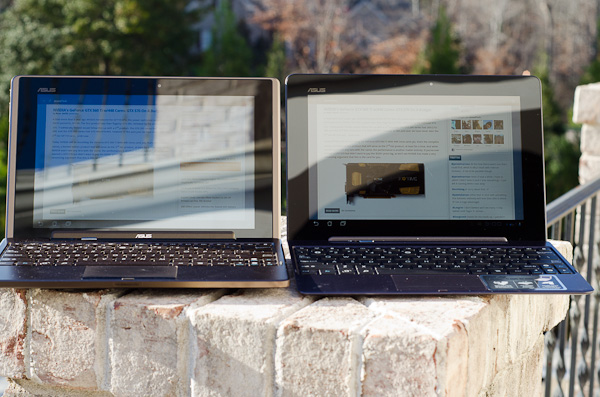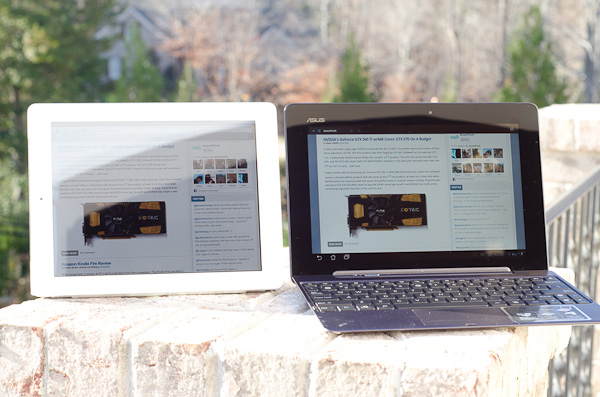ASUS Eee Pad Transformer Prime & NVIDIA Tegra 3 Review
by Anand Lal Shimpi on December 1, 2011 1:00 AM ESTThe Display: Perfect
The original Transformer had a display that performed similarly to the iPad, but was far more reflective thanks to a fairly large gap between the outer glass and the LCD panel underneath. I excused the first generation Eee Pad in the display department because it was good enough and $100 cheaper than the competing Apple solution. The Prime reaches price parity with the iPad 2, and as a result it must meet a higher standard. ASUS doesn't disappoint - the Eee Pad Transformer Prime has the best display I've seen on a tablet to date.
The resolution is a Honeycomb-standard 1280 x 800. The 16:10 panel measures 10.1-inches diagonally, giving it a very similar surface area to the iPad 2's 9.7-inch 4:3 display. The increase in resolution more than makes up for the larger screen however, ASUS delivers 145 pixels per inch compared to the iPad 2's now quite-dated ~132 PPI.
It's not all about pixel density here, the Transformer Prime has better white and black levels than anything else in its class. It also sets the new benchmark for contrast ratio at nearly 1200:1. The huge gap between the outermost glass and the IPS LCD panel has been reduced significantly, in turn reducing glare.



ASUS also has a Super IPS+ mode that drives the display to a class-leading 683 nits. The Super IPS+ mode obviously draws more power but ASUS recommends it if you're trying to use your tablet outdoors. In our review of the PlayBook we found that 600 nits was really the cutoff for usability in sunny conditions, and ASUS easily exceeds that. It's also worth pointing out that while Super IPS+ increases black levels as well, the resulting contrast ratio remains the same.

Original TF (left) vs. Super IPS+ enabled on the TF Prime (right)

iPad 2 (left) vs. Super IPS+ enabled on the TF Prime (right)
Viewing angles are absolutely awesome. Yes this is the same ASUS that let us down with the UX panels but it definitely got the panel right when it came to the Transformer Prime. Fingerprints are still going to be evident on the display but they don't seem to be as bad as on the original Transformer, and they do wipe off easily. This time around ASUS bundles a microfiber cloth to aid in keeping your Transformer looking fresh.
ASUS, Apple and the rest of the tablet world are in hot pursuit of even higher resolution panels, the problem is yields on these small 1080p and 2048x1536 panels just aren't high enough yet. The Android crowd will have to wait, although Apple is apparently pushing very hard (and trying to buy up a lot of inventory) to deliver a "retina display" equipped iPad 2+/3 by Q2 next year. I'm hearing Q3/Q4 for everyone else and it's still not a guarantee that Apple will be able to meet its aggressive targets either at this point.










204 Comments
View All Comments
medi01 - Thursday, December 1, 2011 - link
So am I.But as I recently discovered, it's much easier to switch on tethering on my phone and connect via wi-fi than to swap sim card between devices..
It was hard for me to justify having 2 internet enabled sim cards, but it might be just me.
Kegetys - Thursday, December 1, 2011 - link
I find tethering to be a huge battery drain for the cellphone and it's usually not that practical either for anything else than occasional "emergency" use. But I have three sim cards from my carrier all with unlimited use anyway so I dont need to do any sim swapping. I guess if you need to pay extra for that then tethering is a reasonable alternative.MiSoFine - Thursday, December 1, 2011 - link
3 SIM cards with unlimited use for no extra cost? Who's your carrier? I was going to suck it up and pay AT&T the extra money for tethering, but if that's an option, I'll take it!Kegetys - Thursday, December 1, 2011 - link
> Who's your carrier?Saunalahti :)
medi01 - Thursday, December 1, 2011 - link
Hi,could you include "time it takes to fully charge" please?
On samsung tab it takes surprisingly long (about 4 hours) for some it might matter.
metafor - Thursday, December 1, 2011 - link
That's going to be true of any device that standardizes on a USB 2.0 connection -- which I think all Android tablets thus far use; it's just a different connector.iDevices sort of get around this by using a non-standard USB connection (up to 1A vs the standard 500mA) which is why it can charge faster.
It won't be until USB 3.0 becomes more common that charging speeds will really pick up.
Mugur - Friday, December 2, 2011 - link
Well, this is not quite right. My 2 phones have 1000mA chargers through USB even if the standard for pc is max 500mA. My Nook Color has a non standard but downwards compatible USB charger with around 1900mA.I agree though that the tablets recharge time is slow...
anandtech pirate - Thursday, December 1, 2011 - link
the PowerVR SGX 543MP2 is a beast. I still remember waaaay back when powerVR used to make pc graphic cards.Death666Angel - Thursday, December 1, 2011 - link
They still do Intel integrated graphics in the Atom, if I'm not mistaken. :-) They were the supplier of all Intel motherboard IGPs as well, though those aren't around anymore. :DPenti - Friday, December 2, 2011 - link
They were not the supplier of Intel's IGP's, only the Atom US15W/L/US11L one and some (not all) of the Atom integrated graphics in the CPU and in variants of SoC. Intel has made their own graphics since i740. Thus Intel GMA is their own tech. Own drivers. And so on. Only GMA500 and GMA600 (SoC), and newer GMA3600 and 3650, and likely GMA5650 in D2600/2700 is PowerVR. They don't have exactly excellent drivers for Windows and GNU/Linux desktops.GMA3150 is Intel, which runs in the latest Intel Atom N4XX and N5XX series, D4XX and D5XX.